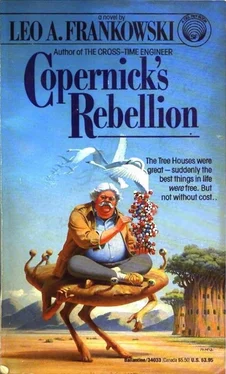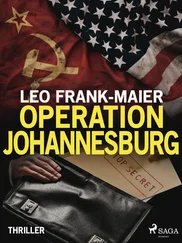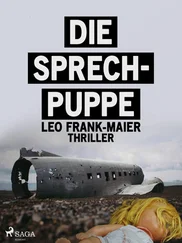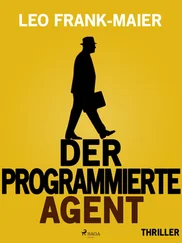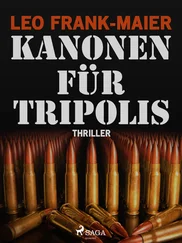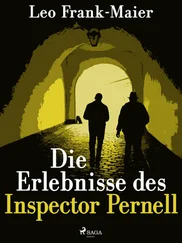Guibedo climbed Pinecroft. Still a wanted man, he couldn’t attend the press conference at the auditorium, but he could see the flash of strobes, the milling crowds. None of Copernick’s creations was in sight. They had been hidden, and the valley’s citizens had been cautioned not to mention them.
He could make out the long line of beds set up near the band shell, an outdoor hospital and morgue.
Guibedo watched the swans flying high and away. “Fly high, my pretty friends. Do your job, and this will never happen again.”
Each of the myriad birds headed to its five-square—mile target zone, then started flying a zigzag pattern. At four-second intervals, it discharged two mosquitoes, one a shiny aluminum, the other a duller iron. When it had discharged 1,024 of each insect, it froze in the air, its programming and life completed. It fell to the ground and became fertilizer for the food-making tree in its breast.
Each of the mosquitoes sought out metal. A car, a plane, a tin can. It laid an egg and flew on to do it again, a thousand times more. And then it died.
Each egg hatched and grew into a larva which, in three days’ time, would eat two ounces of metal and then become a mosquito and lay a thousand eggs of its own.
They would do this for eighty generations, and then their short-lived race would become extinct. Or rather, would try to, for after forty generations there would be neither iron nor aluminum nor any of their alloys left in an unoxidized state on Earth.
Patricia Cambridge came up and stood at Martin Guibedo’s side.
“There were too many old colleagues at the press conference. It sort of hurt, seeing them again. We talked, but I wasn’t one of them anymore.”
“It doesn’t matter, Patty. The world you knew has ended. Now we will build a better one.”
Patricia thought he was talking of love, and snuggled closer.
Chapter Nine
JUNE 20, 2003
MAINTENANCE of a proper resource allocation scheme will require a continuously updated local census of the humans and other bioforms under our jurisdiction.
Local ganglia are therefore instructed to inform me of all human activities within their assigned areas.
—Central Coordination Unit
“I’m sorry that it had to be you, George,” General Powers said. “You were right in doing what you did, and it certainly wasn’t your fault that the bomber crashed. But political realities force me to relieve you of your command.”
“Yes, sir.”
“Officially, our position is that you went insane because of the death of your family some years ago. You will be assigned to a psychiatric ward under sedation for about a month. By that time we should have a final solution to this bioengineering problem, and your name can be cleared,” Powers said.
“A month or so in the funny farm won’t kill me, sir.”
“No point in that. I said ‘officially.’ Actually, I’d just like you to go away for a while. Take a vacation somewhere. You’ll know when you should come back.”
“Thank you, sir.”
“And have a good time.”
Hastings cut himself a set of orders assigning himself to the 315th Fighter-Bomber Squadron at Westover Field, Massachusetts. Then he cut a second set reassigning himself, his plane, and one atomic bomb to the Naval Testing Lab in San Diego.
Eight hours after leaving General Powers’ office, Hastings was flying his F-38 Penetrator at forty thousand feet over the Utah desert. Death Valley was thirty minutes away.
“Like the man said, if you want something done right, you’d better do it yourself,” Hastings said aloud to himself.
Directly below him, a single mindless larva was sinking its solid diamond teeth into a contact pin of an electrical connector. This connector was mounted directly to the solid-fuel rocket that powered the F-38’s ejection seat. The contact tasted bad, like gold, so the larva crawled to the next pin to see if it was aluminum. In the process, its aluminum body touched both contacts simultaneously and the resulting electrical current killed it. It also ignited the solid fuel rocket, which blasted Hastings out through the F-38’s plastic canopy.
Hastings was unconscious, but his flight suit had been designed for use at L-5. It protected him from the cold and near vacuum. At five thousand feet, his parachute opened automatically.
The plane had been set on full automatic and programmed to fly to San Diego, so that its transponder could assure Ground Control that the aircraft’s flight plan was being followed. It continued the journey without pilot or canopy, made a perfect landing on its assigned runway, and stopped, awaiting further instructions. Within minutes it was visited by an egg-laying mosquito.
The crash truck was unable to go out to the plane to investigate. A larva had eaten a hole in the truck’s fuel pump.
The swans looked like ordinary birds, and so attracted little attention. Bored radar operators noticed unusual migration patterns, and properly logged them. But the logs were not due to reach the scientific community for months, and actually would never be examined at all.
Each swan died and fell in the center of its assigned area. Copernick had decided that the food trees, and thus the population, should be scattered as far as possible, to limit the possibility of riots and plagues and to keep them isolated when they occurred.
But if the scientific community failed to notice the swans, the animal community did not. Over half the fallen swans were eaten by animals or other birds. This possibility had been taken into account. The seeds were hard, small, and indigestible. They sprouted, absorbing the flesh around them. The scavengers died, and provided additional fertilizer.
Less than a hundred swans were eaten by people, and cooking destroyed most of the seeds. In eleven cases the swans were not properly cooked, and the people died.
But people who eat raw carrion do not notify authorities when a death occurs. Nor do they perform autopsies or embalm their dead. The trees grew.
Two hundred and eighteen professional biologists across the world found first-generation larvae and excitedly took them into labs to study. Incredible! An insect with a biochemistry different from anything previously known. They hurriedly prepared preliminary reports, each expecting to be the first to publish.
A first-generation larva had been laid on the wing of a DC-16. Unnoticed in the course of three days, it ate its way into the tubular aluminum wing strut. There it metamorphosed into a mosquito, which was unable to fly out of the two hundred-foot sealed chamber. It laid its thousand eggs along the length of the wing and died.
Two days later a thousand larvae were contentedly munching away. Eleven hundred passengers were aboard the Qantas airliner, with a crew of forty taking them from Los Angeles where it was midsummer to Melbourne in the middle of its whiter. Skirting a hurricane south of Hawaii, the left whig sheared off. There were no survivors.
* * *
Another first-generation egg was laid on the side of an aging space shuttle. It was just burrowing its way into the cabin at takeoff, and the small air leak wasn’t noticed until the ship was in orbit. The larva ate its way into the cargo compartment and then into the chassis of a strip-chart recorder. With its cargo unloaded at a station in a low polar orbit, the shuttle returned. Its departure left the wheel-shaped space station with only one small ship capable of landing on Earth. The larva metamorphosed in a biology lab during a sleep period and laid eight hundred eggs before an astronomer swatted it. None of these eggs reached maturity; many of them were blown out into space when they ate through the outer walls. The rest died when the station became airless.
Читать дальше
